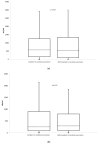Food Hygiene Surveillance in Italy: Is Food Ice a Public Health Risk?
- PMID: 32252266
- PMCID: PMC7178082
- DOI: 10.3390/ijerph17072408
Food Hygiene Surveillance in Italy: Is Food Ice a Public Health Risk?
Abstract
Food ice is used as an ingredient or as a coolant in drinks and in the storage of food, especially fishery products. Studies show that ice can be polluted both by chemical substances and by bacteria and fungi. In particular, the presence of fungi in these food matrices has acquired an important role in Public Health, as it can represent a risk factor for fungal complications in immunocompromised subjects. In the present study we evaluated the hygiene-sanitary quality of food ice from public and collective catering establishments in a large area of Southern Italy, investigating the mandatory parameters (Escherichia coli, coliform and Enterococci) and some accessory parameters (Staphylococcus aureus, Pseudomonas aeruginosa and fungi) provided for Italian Legislative Decree 31/01. Although 54.5% of samples were compliant, the results highlight a vast contamination of food ice by bacteria and fungi. In particular, 95.8% of samples were contaminated by fungi, stressing no difference between compliant and non-compliant samples. Their presence is generally attributable to the poor sanitation conditions in the production and/or administration phase and to the incorrect sanitization and ordinary maintenance procedures. It seems appropriate to suggest the need to carry out a specific risk assessment with respect to the self-control plans.
Keywords: E. coli; Public Health; coliform; food hygiene; food ice; fungi.; ice machines; microbial contamination.
Conflict of interest statement
The authors declare no conflict of interest.
Figures


References
-
- Settanni L., Gaglio R., Stucchi C., De Martino S., Francesca N., Moschetti G. Presence of pathogenic bacteria in ice cubes and evaluation of their survival in different systems. Ann. Microbiol. 2017;67:827–835. doi: 10.1007/s13213-017-1311-1. - DOI
-
- Istituto Nazionale Ghiaccio Alimentare (INGA) Manuale di Corretta Prassi Operativa per la Produzione di Ghiaccio Alimentare. [(accessed on 10 January 2020)];2015 Available online: http://www.ghiaccioalimentare.it/ilmanuale/
-
- Portale Acque Ministero della Salute. [(accessed on 10 January 2020)]; Available online: http://www.portaleacque.salute.gov.it/PortaleAcquePubblico/noteInformati....
-
- Teixeira P., Brandão J., Silva S., Novak Babi M., Gunde-Cimerman N., Pires J., Costa S., Valério E. Microbiological and chemical quality of ice used to preserve fish in Lisbon marketplaces. J. Food Saf. 2019;39:e12641. doi: 10.1111/jfs.12641. - DOI
-
- Decreto Legislativo 2 Febbraio 2001, n. 31 “Attuazione Della Direttiva 98/83/CE Relativa alla Qualità Delle Acque Destinate al Consumo Umano” Gazzetta Ufficiale n. 52 del 3 Marzo 2001—Supplemento Ordinario n. 41. [(accessed on 10 January 2020)]; Available online: https://www.camera.it/parlam/leggi/deleghe/01031dl.htm.
Publication types
MeSH terms
Substances
LinkOut - more resources
Full Text Sources
Medical

